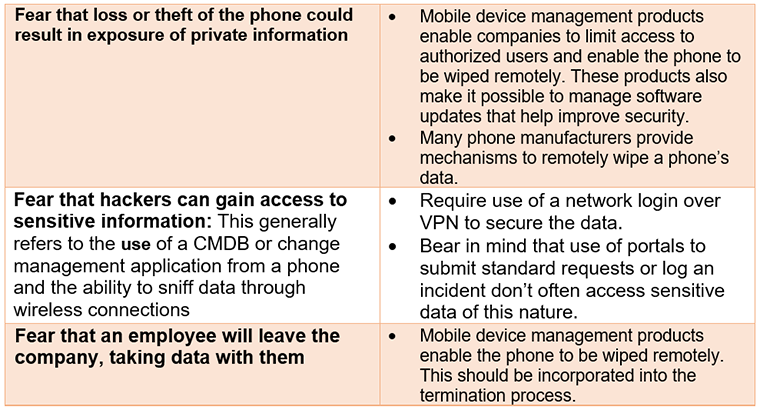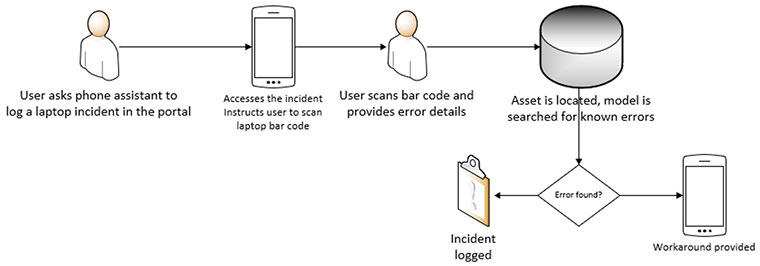Date Published March 12, 2020 - Last Updated September 2, 2020
The world is moving on and cell phones are our new computers. As business apps continue to grow, more and more tasks are performed on the go using cell phones. Cell phones change the support game—IF the software provider is innovative and offers integrated solutions and IF the latest and best mobile features are enabled and leveraged. After a brief look at why some organizations opt not to provide mobile capabilities for engaging with IT and other internal providers, this article looks at how the cell phone provides an enhanced employee experience, elevating the perception of IT’s value.
The Problem
While more and more businesses are moving towards cell phone enablement, there are still organizations that do not allow employees to access resources from their phones. There are some valid reasons for this, as described in the table below. But many of these reasons are easily overcome with the solutions shown:

The bottom line is that, while organizations have many reasons to be concerned about allowing employees to access corporate resources from their cell phone, there is both demand for such use and products available to provide safe access. It’s no longer good enough to just say no, as it was five years ago.
While organizations have reasons to be concerned about allowing employees to access corporate resources from their cell phone, it’s no longer good enough to just say no.

Game-Changing Support Use Cases for Mobile
Enabling cell phone use for common activities goes well beyond access to email. Where it may have been cumbersome to perform simple functions like attaching a file to an email in the past, even this barrier has come down, with file attachment from within an existing email becoming available in recent operating systems.
Over the past several years, the types of apps available on cell phones has expanded beyond email: it’s very common to see apps for time and expense reporting, service management tools, as well as common office applications like Word, Excel and PowerPoint. Continued application growth can become a game changer for innovative support providers looking to improve the employee experience. So, what can you do today?

Number 1: Portal
If you haven’t already made a service portal available to mobile devices, now is the time!
Many organizations fear that making support available via a portal means people can use the portal to access information that needs to be secured, like configuration information. The reality is that the portal exposes what you expose via reference tables and automated data population. But hacking the portal will simply get people into the portal, not the back-end service management tool (in most cases). There are several considerations from a security and usability standpoint:
- Make sure your portal design is responsive, that it adjusts to standard cell phone website appearance and use automatically.
- Take care with form design. Make it easy to complete and submit forms via a cell phone by requiring as little data entry as possible (use drop downs and radio buttons as much as possible).
- Make sure you don’t expose sensitive data with your processes: HR organizations that put job change/promotion requests in a portal often want to auto-fill the current salary based on the employee selected. But unless you can secure this so that only a manager has access to the form and they see only their team, anyone could use the form to see someone’s salary.
Number 2: Chat Bots and Phone Assistants
Many modern portals come with some form of chat bot that can take first line support questions and refer anything not in the knowledge base or available through machine learning to agents working a chat queue. If you’re not using all of these, now is the time!
There are several considerations and voice-based services that can be investigated in your toolset:
- Chat bots are generally easy to implement if there’s a current knowledge base and/or if they can leverage a large ticket base (supported with machine learning capabilities) to find answers for customers.
- The experience can end in logging a ticket or passing the consumer to a human staffing a chat queue. Since the latter is a better experience, implement live chat along with chat bot usage (if it’s not already in place). Think of the chat bot as the first line and the live agent as second line. If you can peel off significant volume using the chat bot, agents can be put to more valuable use than answering easy how-to questions.
Service Management solutions are now expanding the abilities of their chat bot functions with natural language and integration to phone assistants, giving people the ability to interact just like they do with their phone. This is an expanded capability that makes it easier to use these services from a cell phone using native phone technology.
Number 3: Self-Service
Portal-based self-service isn’t new, but with a phone assistant integrated to the ticketing aspect of the portal and with the ability to attach a photo of a screen or to use the phone to scan a bar code, the ability to log an incident with required information changes a bit.
Consider this experience map of a potential mobile interaction:

In this example, the user never typed a thing: the system knew who it was by their phone number, a bar code was accessed via the phone’s camera, the CMDB and known error data base was automatically searched to see potential workarounds and if none were found, the incident was logged and triaged in the background. All the user had to do was ask their phone assistant to log a laptop issue. The rest was automated workflow to drive a result.
There could be a heavy lift to design the incidents and workflows to support this capability. But starting with the most inconvenient and highest volume issues first can have a big bang for the buck, so now is the time!
Number 4: Onboarding
The process of onboarding a candidate has changed completely for organizations that have enabled their technology to work via the phone, enabling the entire process to be managed via the candidate’s mobile device. If you haven’t begun to employ these capabilities, now is the time!
- E-signature enables candidates to review and authorize background screening processes that have been prepared and pre-filled by the talent acquisition team.
- The ability to complete a PDF document and attach it from a phone enables the candidate to complete new-hire paperwork and submit it from their phone (if desired).
- Constant communication via email with access to their onboarding record in a service management portal enables similar processes throughout the experience, even reviewing video training modules.
This resonates with millennials who are often on the go and very attached to their phone, making it easy to attract young talent.
Number 5: IT Enablement
IT can use the same capabilities as employees to access their work, log requests for change on the go, and perform other tasks. Again, imagine a field tech asking their phone assistant for the next ticket in their queue and then requesting directions to the location via their phone’s mapping program. Once at the customer, they can ask for the ticket to be displayed, update it, and move on. In a similar way, an emergency change could be logged via the phone’s assistant, again leveraging a device’s bar code to find the correct configuration item and log the change against it. The technology is the same as described earlier in this article, but with use cases aimed at IT. If IT enablement would make it easier to manage the volume, now is the time!
The Benefits
Ultimately, there is tremendous value to integrating service management tool use with mobile devices. While some of the use cases here may not be able to be performed with all service management platforms, there are some that do, and this is an emerging area. If you can’t do some of these things yet, consider the ones you can and implement them to realize some benefits:
- Improved user experience, higher customer satisfaction
- Prompt reporting of issues, particularly those that are made more difficult by the remote location of the item (for example, a network printer that’s not by the user’s desk)
- Ability to deliver support more quickly and efficiently
- Process adoption: make it easy to log a change while making a repair, right from the rack housing the infrastructure component
Phyllis Drucker is an ITIL® certified consultant and information leader at Linium, a Ness Digital Engineering Company. Phyllis has more than 20 years of experience in the disciplines and frameworks of IT service management, as both a practitioner and consultant. She has served HDI since 1997 and itSMF USA since 2004 in a variety of capacities including speaker, writer, local group leader, board member, and operations director. Since 1997, Phyllis has helped to advance the profession of ITSM leaders and practitioners worldwide by providing her experience and insight on a wide variety of ITSM topics through presentations, whitepapers, and articles and now her new book on the service request catalog, Online Service Management: Creating a Successful Service Request Catalogue (International Best Practice). Follow Phyllis on Twitter @msitsm.